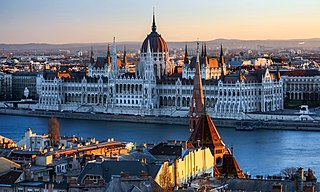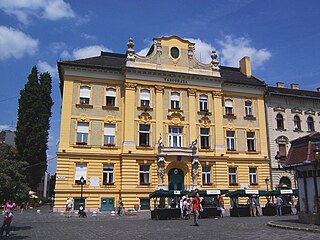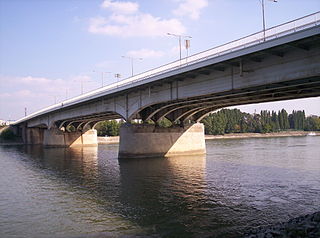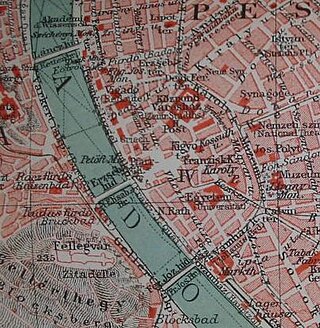
Budapest is the capital and most populous city of Hungary. It is the ninth-largest city in the European Union by population within city limits and the largest city on the Danube river; the city has an estimated population of 1,752,286 over a land area of about 525 square kilometres. Budapest, which is both a city and county, forms the centre of the Budapest metropolitan area, which has an area of 7,626 square kilometres and a population of 3,303,786. It is a primate city, constituting 33% of the population of Hungary.

Pannonia was a province of the Roman Empire bounded on the north and east by the Danube, coterminous westward with Noricum and upper Italy, and southward with Dalmatia and upper Moesia. Pannonia was located in the territory that is now western Hungary, western Slovakia, eastern Austria, northern Croatia, north-western Serbia, northern Slovenia, and northern Bosnia and Herzegovina.

Buda was the historic capital of the Kingdom of Hungary and, since 1873, has been the western part of the Hungarian capital Budapest, on the west bank of the Danube. Buda comprises a third of Budapest's total territory and is mostly wooded. Landmarks include Buda Castle, the Citadella, and the president of Hungary's residence, Sándor Palace.

Pest is the eastern, mostly flat part of Budapest, Hungary, comprising about two-thirds of the city's territory. It is separated from Buda and Óbuda, the western parts of Budapest, by the Danube River. Among its most notable sights are the Inner City, the Hungarian Parliament Building, Heroes' Square and Andrássy Avenue.

Inner City the central part of Budapest. It is more or less equivalent with the historic old town of Pest.

Óbuda was a town in Hungary that was merged with Buda and Pest on 17 November 1873; it now forms part of District III-Óbuda-Békásmegyer of Budapest. The name means Old Buda in Hungarian. The name in Serbo-Croatian for this city is Stari Budim, but the local Croat minority calls it Obuda. In Czech and the Slovak languages, it is called Starý Budín.

Árpád Bridge or Árpád híd is a bridge in Budapest, Hungary, connecting northern Buda (Óbuda) and Pest across the Danube.

Central Hungary is one of the seven statistical regions in Hungary. It includes Budapest and Pest County.

The Danube Promenade is located on the Pest side of Budapest, Hungary. The promenade itself lies on the left bank of the Danube, extending from the Széchenyi Chain Bridge to the Erzsébet Bridge.

The city of Budapest was officially created on 17 November 1873 from a merger of the three neighboring cities of Pest, Buda and Óbuda. Smaller towns on the outskirts of the original city were amalgamated into Greater Budapest in 1950. The origins of Budapest can be traced to Celts who occupied the plains of Hungary in the 4th century BC. The area was later conquered by the Roman Empire, which established the fortress and town of Aquincum on the site of today's Budapest around AD 100. The Romans were expelled in the 5th century by the Huns, who were challenged by various tribes during the next several centuries. The Hungarian conquest of the Carpathian Basin started at the end of the 9th century, and the Kingdom of Hungary was established at the end of the 11th century.

Páty is a village in Pest county, Budapest metropolitan area, Hungary. It has a population of 7,476 (2018). The neighbouring villages are: Zsámbék, Tök, Budajenő, Telki, Nagykovácsi, Budakeszi, Biatorbágy and Herceghalom. The Zsambeki basin are bound by Mézes (Honey) valley which is called as the Gate of Páty also. The Paty-basin is 180 m over the sea level in general, but its outskirts reach 210–360 m high.

Pilisborosjenő is a village in Pest county, Budapest metropolitan area, Hungary. It has a population of 3,373 (2012).

Pilis Mountains is a mountainous region in the Transdanubian Mountains. Its highest peak is Pilis-tető at 756 meters (2,480 ft). It is a popular hiking destination in Hungary.

Aquincum was an ancient city, situated on the northeastern borders of the province of Pannonia within the Roman Empire. The ruins of the city can be found today in Budapest, the capital city of Hungary. It is believed that Marcus Aurelius wrote at least part of his book Meditations at Aquincum.

Aquincum Institute of Technology (AIT) is a study abroad opportunity for North American undergraduates in Budapest, Hungary. AIT offers undergraduate programs in computer science, software engineering, and information technology. Established in 2007, the program was created by the businessman Gábor Bojár, founder of Graphisoft. After Bojár sold Graphisoft, he used a majority of the profit from this sale to found AIT in an effort to "Invest in People.". The first official semester was Spring 2011. Each semester, approximately 30-50 North American students study at AIT.

Aquincum Civil Amphitheatre is an ancient structure in Budapest, Hungary, the lesser of two located in Obuda. The other is the Aquincum Military Amphitheatre. It was built between 250 AD and 300 AD. South of the western gate is an inscription of the Greek goddess Nemesis also known as Rhamnousia/Rhamnusia.

The Aquincum Military Amphitheatre is the greater of two amphitheatres in Budapest, Hungary, the other being the Aquincum Civil Amphitheatre. It is located in the Obuda district, just north near the Danube river. It was built around 145, during the reign of emperor Antoninus Pius.

Paula Zsidi is a Hungarian archeologist, art historian, author, and museologist.

KláraPóczy was a Hungarian archaeologist, who specialised in the Roman heritage of the Pannonian cities, especially Budapest. She was also Director of the Aquincum Museum, from 1963 to 1973.




















